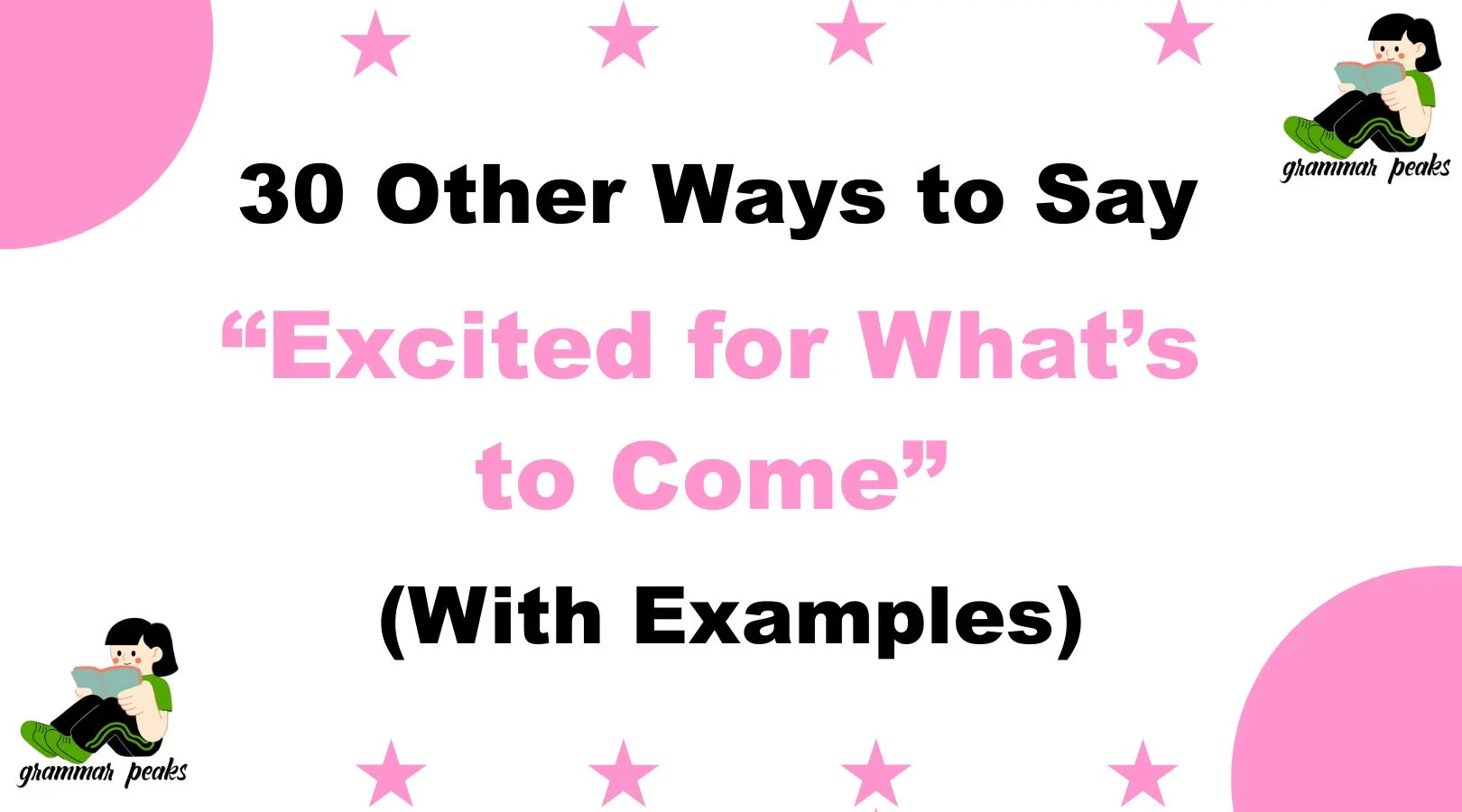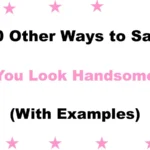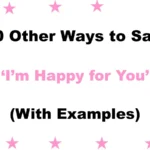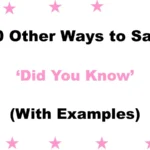In both professional and personal conversations, saying you’re “excited for what’s to come” can express optimism, hope, and enthusiasm for the future. But sometimes, this phrase feels a bit worn out or generic.
Whether you’re writing an email, sharing a social post, or ending a meeting on a high note, using fresh and specific alternatives can help you sound more authentic, memorable, and emotionally engaged. This list offers 30 powerful alternatives—each one uniquely tailored for different tones, situations, and communication goals.
What Does “Excited for What’s to Come” Mean?
The phrase “excited for what’s to come” expresses eagerness or optimism about the future, often after a milestone, transition, or opportunity. It can be used in both formal and informal contexts to signal enthusiasm, hope, or readiness for the next stage.
When to Use “Excited for What’s to Come”
Use this phrase when:
- Wrapping up a big change (e.g., finishing a project or starting a new role)
- Sharing your forward-looking mindset in public updates or posts
- Ending messages or meetings on a positive, uplifting note
- Reassuring others during uncertain or transitioning times
Is It Professional or Polite to Say “Excited for What’s to Come”?
Yes, it’s polite and generally considered professional. However, it may lack specificity or originality in more formal documents or announcements. That’s why alternatives can be more impactful, especially when tailored to the audience or occasion.
Pros and Cons
Pros:
- Universally positive and polite
- Works in both written and spoken communication
- Easily understood across cultures and professions
Cons:
- Overused in corporate language
- Can sound vague or empty without context
- May feel impersonal in heartfelt communication
Synonyms For Excited for What’s to Come:
- Looking Forward to the Future
- Eager for the Next Chapter
- Can’t Wait to See What Happens Next
- Excited About the Journey Ahead
- Thrilled About What Lies Ahead
- Hopeful for What’s Next
- Energized for What’s Coming
- Open to the Possibilities Ahead
- Ready for a New Adventure
- Looking Ahead With Optimism
- Grateful for What’s Ahead
- Ready to Embrace the Future
- Excited for the Opportunities Ahead
- Anticipating Great Things to Come
- Feeling Positive About What’s Next
- Can’t Wait for the Next Step
- Looking Ahead With Hope
- Feeling Inspired for What’s Next
- Enthusiastic About the Road Ahead
- Motivated for What’s to Come
- Excited to See What the Future Holds
- Looking Forward With Confidence
- Welcoming the Future With Open Arms
- The Best Is Yet to Come
- Charged Up About What’s Next
- Leaning Into the Future
- Optimistic About What’s Around the Corner
- Inspired by the Possibilities Ahead
- Onward With Purpose
- Excited to Turn the Page
1. Looking Forward to the Future
Definition: A hopeful expression of optimism.
Explanation: A gentle, respectful phrase that implies hope and confidence.
Example: “I’m looking forward to the future with this incredible team.”
Best Use: Business emails, transitions, long-term plans.
Worst Use: Casual chats or when a more emotional phrase is needed.
Tone: Professional, calm, respectful.
2. Eager for the Next Chapter
Definition: Ready and enthusiastic for what’s next.
Explanation: Adds a narrative tone to your excitement.
Example: “Graduation is bittersweet, but I’m eager for the next chapter.”
Best Use: Life milestones, personal announcements.
Worst Use: Highly technical or business updates.
Tone: Warm, hopeful, emotional.
3. Can’t Wait to See What Happens Next
Definition: Enthusiastically anticipating what’s ahead.
Explanation: Casual, fun, and upbeat.
Example: “What a journey—it’s been wild! Can’t wait to see what happens next.”
Best Use: Social media, team celebrations.
Worst Use: Formal or corporate reports.
Tone: Casual, energetic.
4. Excited About the Journey Ahead
Definition: Looking forward to the process, not just the outcome.
Explanation: Expresses value in progress and growth.
Example: “We’ve laid a great foundation—excited about the journey ahead!”
Best Use: Team building, leadership updates.
Worst Use: When the outcome is more important than the journey.
Tone: Motivational, grounded.
5. Thrilled About What Lies Ahead
Definition: Extremely excited for the future.
Explanation: Stronger, more emotional version of the original phrase.
Example: “We’re thrilled about what lies ahead for our company.”
Best Use: Public statements, press releases.
Worst Use: One-on-one informal conversations.
Tone: Formal, enthusiastic.
6. Hopeful for What’s Next
Definition: A calm, positive expectation for the future.
Explanation: Expresses optimism without overstatement.
Example: “Though change is hard, I’m hopeful for what’s next.”
Best Use: Emails, sensitive transitions.
Worst Use: When bold energy is needed.
Tone: Gentle, supportive.
7. Energized for What’s Coming
Definition: Feeling active and empowered for the future.
Explanation: Adds a physical sense of readiness.
Example: “After this workshop, I feel energized for what’s coming.”
Best Use: After events, learning sessions.
Worst Use: Situations that require solemnity.
Tone: Upbeat, physical, bold.
8. Open to the Possibilities Ahead
Definition: Optimistic and receptive about the future.
Explanation: Emphasizes flexibility and curiosity.
Example: “This new opportunity has me open to the possibilities ahead.”
Best Use: Career changes, new ventures.
Worst Use: When decisions are already locked in.
Tone: Reflective, creative.
9. Ready for a New Adventure
Definition: Looking forward to an exciting, unknown path.
Explanation: Implies enthusiasm and courage.
Example: “Today marks the end of one era and the start of a new adventure.”
Best Use: New jobs, moves, big changes.
Worst Use: Highly structured or rigid plans.
Tone: Bold, exploratory.
10. Looking Ahead With Optimism
Definition: Expecting positive outcomes in the future.
Explanation: Balanced and reassuring.
Example: “Despite the challenges, we’re looking ahead with optimism.”
Best Use: Team communication, business updates.
Worst Use: If tone needs to be humorous or casual.
Tone: Neutral, positive, thoughtful.
11. Grateful for What’s Ahead
Definition: Expressing thankfulness while looking toward the future.
Explanation: Combines gratitude and hopefulness in one thoughtful phrase.
Example: “I’m truly grateful for what’s ahead and the support I’ve received so far.”
Best Use: Transitions, thank-you messages, milestone posts.
Worst Use: When excitement is the primary emotion you want to express.
Tone: Humble, sincere, appreciative.
12. Ready to Embrace the Future
Definition: Fully accepting and looking forward to what comes next.
Explanation: Shows confidence and emotional readiness.
Example: “I’m ready to embrace the future, no matter what it brings.”
Best Use: Graduation speeches, career shifts, leadership transitions.
Worst Use: Casual conversations.
Tone: Empowered, inspirational.
13. Excited for the Opportunities Ahead
Definition: Looking forward to new possibilities.
Explanation: Highlights specific optimism about new openings or options.
Example: “This team has so much potential—I’m excited for the opportunities ahead.”
Best Use: Work meetings, business growth statements.
Worst Use: Times of hardship or grief.
Tone: Motivated, forward-thinking.
14. Anticipating Great Things to Come
Definition: Expecting positive developments.
Explanation: Confident yet open-ended, suggesting great things are just around the corner.
Example: “We’ve done the work—now I’m anticipating great things to come.”
Best Use: Email sign-offs, positive updates.
Worst Use: Uncertain or pessimistic contexts.
Tone: Hopeful, visionary.
15. Feeling Positive About What’s Next
Definition: Mild but encouraging optimism.
Explanation: Balanced and reassuring without sounding overly excited.
Example: “Even with all the changes, I’m feeling positive about what’s next.”
Best Use: Team morale boosts, calm leadership messages.
Worst Use: High-energy environments.
Tone: Supportive, grounded.
16. Can’t Wait for the Next Step
Definition: High energy and anticipation for what’s coming.
Explanation: Expresses excitement and forward movement.
Example: “We’ve come so far—can’t wait for the next step!”
Best Use: Celebratory contexts, launches.
Worst Use: Highly formal occasions.
Tone: Playful, enthusiastic.
17. Looking Ahead With Hope
Definition: Expecting something better to come.
Explanation: A gentle, emotionally intelligent alternative.
Example: “We’ve weathered a storm, and now we’re looking ahead with hope.”
Best Use: Tough transitions, difficult goodbyes.
Worst Use: Competitive, high-stakes environments.
Tone: Empathetic, healing.
18. Feeling Inspired for What’s Next
Definition: Energized by ideas or purpose going forward.
Explanation: Communicates passion or creative momentum.
Example: “This feedback has me feeling inspired for what’s next.”
Best Use: Creative teams, coaching settings.
Worst Use: Mundane or procedural contexts.
Tone: Inspired, forward-facing.
19. Enthusiastic About the Road Ahead
Definition: Excited about your current direction.
Explanation: Professional and polished way to express readiness.
Example: “We’ve built a solid strategy—I’m enthusiastic about the road ahead.”
Best Use: Business plans, leadership communications.
Worst Use: Informal chats.
Tone: Strategic, poised.
20. Motivated for What’s to Come
Definition: Feeling driven and focused on the future.
Explanation: Adds ambition and purpose to forward-looking language.
Example: “The results so far have me motivated for what’s to come.”
Best Use: Performance reviews, progress reports.
Worst Use: Sentimental or family-oriented conversations.
Tone: Professional, strong.
21. Excited to See What the Future Holds
Definition: Looking forward to whatever unfolds.
Explanation: A hopeful expression with an open mindset.
Example: “It’s been a great year—excited to see what the future holds.”
Best Use: End-of-year notes, life updates.
Worst Use: When a concrete plan or goal is expected.
Tone: Casual, optimistic.
22. Looking Forward With Confidence
Definition: Optimistic with a strong sense of capability.
Explanation: Great for leadership or self-assured transitions.
Example: “With our preparation, I’m looking forward with confidence.”
Best Use: Speeches, executive messaging.
Worst Use: Emotional or personal posts.
Tone: Confident, formal.
23. Welcoming the Future With Open Arms
Definition: Warmly embracing what lies ahead.
Explanation: Positive and emotionally inviting.
Example: “Though it’s the end of a chapter, I’m welcoming the future with open arms.”
Best Use: Life changes, personal growth.
Worst Use: Serious or technical business settings.
Tone: Heartfelt, cheerful.
24. The Best Is Yet to Come
Definition: Belief that even better things are ahead.
Explanation: Timeless and highly optimistic.
Example: “We’ve already achieved so much—and the best is yet to come.”
Best Use: Motivational settings, farewells, celebrations.
Worst Use: When humility or realism is key.
Tone: Inspirational, bold.
25. Charged Up About What’s Next
Definition: Electrified and motivated for future action.
Explanation: Adds energy and youthfulness.
Example: “After that planning session, I’m charged up about what’s next!”
Best Use: Startups, teams, energy-driven environments.
Worst Use: Reserved, conservative contexts.
Tone: Energetic, casual.
26. Leaning Into the Future
Definition: Actively moving forward with intention.
Explanation: Suggests maturity, readiness, and proactive effort.
Example: “Instead of fearing change, I’m leaning into the future.”
Best Use: Leadership development, personal growth.
Worst Use: When levity or excitement is needed.
Tone: Reflective, strong.
27. Optimistic About What’s Around the Corner
Definition: Believing good things are coming soon.
Explanation: A great balance of hope and immediacy.
Example: “This team is doing great—I’m optimistic about what’s around the corner.”
Best Use: Strategic check-ins, forward planning.
Worst Use: Highly emotional goodbyes.
Tone: Positive, composed.
28. Inspired by the Possibilities Ahead
Definition: Seeing creative or transformative potential.
Explanation: Perfect when entering a visionary phase.
Example: “After these strategy sessions, I’m inspired by the possibilities ahead.”
Best Use: Innovation-focused teams, vision decks.
Worst Use: Routine updates.
Tone: Imaginative, empowered.
29. Onward With Purpose
Definition: Moving forward with clear direction.
Explanation: Simple, powerful, and elegant.
Example: “The first chapter ends here—onward with purpose.”
Best Use: Career transitions, leadership writing.
Worst Use: Casual or emotional contexts.
Tone: Resolute, meaningful.
30. Excited to Turn the Page
Definition: Ready for the next phase of your journey.
Explanation: Metaphorical and reflective.
Example: “Leaving this role has been tough, but I’m excited to turn the page.”
Best Use: Farewell messages, narrative posts.
Worst Use: Formal executive summaries.
Tone: Warm, literary.
Conclusion
Finding the right way to express excitement about the future can make a huge difference in how your message is received—whether you’re addressing colleagues, clients, or loved ones. Saying “Excited for what’s to come” is polite and professional, but switching it up with alternatives like “Eager for the next chapter” or “Looking forward with confidence” can make your tone feel more authentic, creative, and tailored to the moment.
The goal is to match your language with your intention: formal or informal, high-energy or reflective, public or private. With these 30 thoughtful alternatives, you’ll never run out of powerful ways to share your optimism for the future—and sound like you actually mean it.
FAQs
Is it okay to say “Excited for what’s to come” in a professional email?
Yes, it’s polite and widely acceptable, but it can feel vague or overused. Consider something like “Looking ahead with confidence” or “Excited about the opportunities ahead” for a more professional tone.
What’s a more emotional or personal alternative to “Excited for what’s to come”?
Try “Grateful for what’s ahead” or “Welcoming the future with open arms”. These add warmth and sincerity.
What’s a more formal way to say “Excited for what’s to come”?
Use phrases like “Enthusiastic about the road ahead”, “Looking forward with confidence”, or “Onward with purpose” in business or formal communication.
Can I use these phrases in social media posts?
Absolutely! Many of these expressions—like “Can’t wait to see what happens next” or “Inspired by the possibilities ahead”—are perfect for LinkedIn, Instagram captions, or blog sign-offs.
How can I sound more original when expressing excitement?
Use metaphors or vivid language like “Excited to turn the page” or “Leaning into the future” to make your message stand out and feel fresh.






